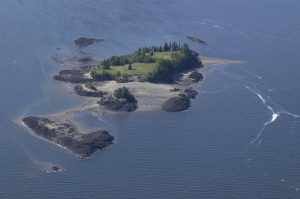What happened?
- In 1604, Pierre Dugua, a French nobleman, along with 79 Frenchmen arrived on the island of St. Croix, in present-day Maine, to establish a new colony. Dugua intended to colonize North America and trade with Indigenous Peoples — primarily the tribes belonging to the Wabanaki Confederacy — for furs. He chose St. Croix because it offered protection from the Indigenous Peoples as well as the English.
- Winter that year came early and was extremely severe, with the first snow on October 6th. Of the 79 men, 35 died and more than 20 were on the verge of death, both from the cold and from scurvy because they ate nothing but salted food. Once spring came, and the ice surrounding the island melted, the remaining men left to find a more hospitable site for a colony.
- Had the settlers not left as a result of illness and the extreme weather, the island may have become part of the French colonies. Instead, the remaining buildings were left to Membertou, chief of the Mi’kmaq peoples. In 1613, Captain Argall of Virginia carried out orders to drive the French from the coast, and destroyed the buildings.

An overhead view of St. Croix Island, which today is an International Historic Site (from Visit Maine).
How is this related to climate?
- The winter of 1604 was the coldest winter in decades, and the French settlers were unprepared for its severity.
- The Little Ice Age, a period of widespread cooling between 1300 and 1850, contributed to this particularly cold winter.
References and additional resources:
- Cousins, C. “An Island Prison: Rugged St. Croix Island Brought Ghastly Death to Early Settlers.” Bangor Daily News. 2011. https://bangordailynews.com/2011/08/19/news/an-island-prison-rugged-st-croix-island-brought-ghastly-death-to-early-settlers/.
- Lieberman, B. and Gordon, E. Climate change in human history: prehistory to the present. London, Bloomsbury Academic, 2018.
- “Saint Croix Island International Historic Site.” Visit Maine, n.d. https://visitmaine.com/organization/saint-croix-island-international-historic-site/3573bcef-e51a-4bd9-99ae-e9883c55d1f3.
- “Samuel de Champlain 1604-1616.” Virtual Museum of New France, n.d. https://www.historymuseum.ca/virtual-museum-of-new-france/the-explorers/samuel-de-champlain-1604-1616/.
- “Six Ways the Little Ice Age Made History.” New England Historical Society, 2018. http://www.newenglandhistoricalsociety.com/six-ways-little-ice-age-made-history/.
- “St. Croix Island, The Lost French Colony of Maine.” New England Historical Society. 2016. https://www.newenglandhistoricalsociety.com/st-croix-island-lost-french-colony-maine/.
